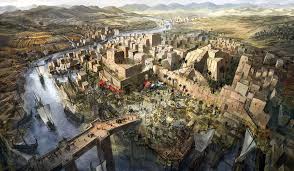Sumer was the first urban civilization in the historical region of southern Mesopotamia, modern-day southern Iraq, during the Chalcolithic and Early Bronze ages, and arguably the first civilization in the world with Ancient Egypt and the Indus Valley. Living along the valleys of the Tigris and Euphrates, Sumerian farmers were able to grow an abundance of grain and other crops, the surplus of which enabled them to settle in one place.
https://en.wikipedia.org/wiki/Sumer
7 June, 2015 – 14:44 Bryan Hill
The Rise and Fall of Sumer and Akkad
(Read the article on one page)
The Sumerians were the first known people to settle in Mesopotamia over 7,000 years ago. Located in the southernmost part of Mesopotamia between the Tigris and Euphrates rivers (modern day Iraq), Sumer was often called the cradle of civilization. By the 4 th millennium BC, it had established an advanced system writing, spectacular arts and architecture, astronomy and mathematics. The Akkadians would follow the Sumerians, borrowing from their culture, producing a new language of their own, and creating the world’s first empire.
The origin of the Sumerians remains a mystery till this day. They called themselves Saggiga (the “black-headed” or “bald-headed ones”) and their country, Kengi (“civilized land”). Some believe they came from around Anatolia or modern day Turkey. Others suggest they might have come from India and were Caucasian in origin. They were established in southern Babylonia, in what is now Iraq, by at least 3500 BC.
Located in what the ancient Greeks called Mesopotamia, meaning “the land between the rivers,” Sumer was a collection of city-states or cites that were also independent nations, some of which endured for 3,000 years. Beginning around 3500 BC, the Sumerians began to build walled cities, including Ur, the capital of the civilization. Each of these cities contained public buildings, markets, workshops, and advanced water systems, and were surrounded by villages and land for agriculture. Political power originally belonged to the citizens, but as rivalry between the various city-states increased, each adopted the institution of kingship.
Each city-state was believed to be under the rule of a local god or goddess and their temples dominated the towns architecture. The most famous temple, the Ziggurat of Ur was a three-storied, 15m (49 ft) high building constructed from mud bricks in the form of pyramidal graduated terraces. It formed a complex of temples and included the royal palace. On top of the structure was a shrine dedicated to the god of that city.
